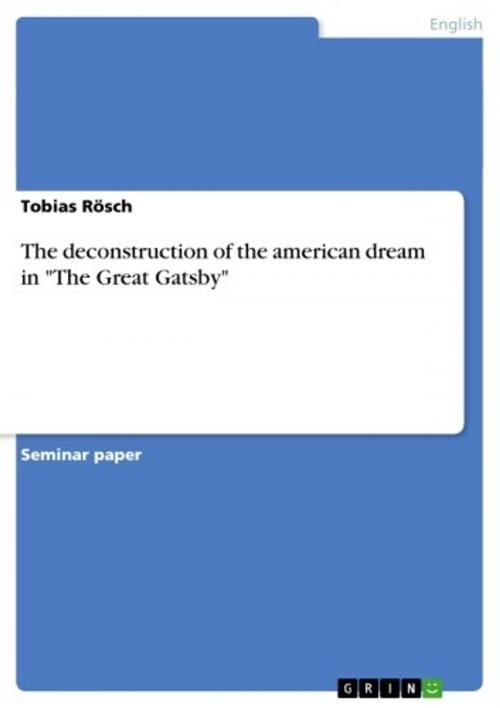The deconstruction of the american dream in 'The Great Gatsby'
Nonfiction, Entertainment, Drama, Anthologies| Author: | Tobias Rösch | ISBN: | 9783640105939 |
| Publisher: | GRIN Verlag | Publication: | July 17, 2008 |
| Imprint: | GRIN Verlag | Language: | English |
| Author: | Tobias Rösch |
| ISBN: | 9783640105939 |
| Publisher: | GRIN Verlag |
| Publication: | July 17, 2008 |
| Imprint: | GRIN Verlag |
| Language: | English |
Seminar paper from the year 2006 in the subject American Studies - Literature, grade: 1.0, University of Freiburg (Englisches Seminar), course: Modernism and the American Fiction, 13 entries in the bibliography, language: English, abstract: Robert Frost, a contemporary of Francis Scott Fitzgerald, once said that 'poetry is a way of taking life by the throat.' In Fitzgerald's fabulous novel The Great Gatsby, published in 1925, this seems to be the author's intention, when in a largely poetic tone he depicts life in the so-called 'Roaring Twenties'. He took life by the throat and simultaneously pointed at social injustices that were accompanying the economic prosperity of his time. Fitzgerald's masterpiece primarily deals with the American upper class in the 1920s and demonstrates some of the internal processes of 'high society.' In the novel representatives of the upper class are engaged in acts of egotism, self-aggrandizement, and heartlessness. Their ubiquitous lack of empathy and understanding for the concerns of others, their downright brutality and self-centeredness pervades the whole storyline and gives prove of the author's rather pessimistic view of what was then going on in contemporary America. In the center of things stands the character after whom the novel is named: Jay Gatsby. He is a rather prototypical upstart American who within a short period of time has found ways and means to make a fortune. His wealth is derived mainly from bootlegging and other criminal activities that are left concealed to the reader. At any rate, Jay Gatsby comes in touch with the seducing realm of opulence at a very early stage when aged 17 he encounters destiny for the very first time. The event that would shape his whole life and leave an imprint on his mind is a chance meeting with Dan Cody, a rich mining tycoon, who cruises across Lake Superior in his yacht Tuolomee (named after the gold fields of Northern California1) some day. From this day on Gatsby's life will never be the same: the seed of aspiration has been planted in the young man's heart together with a deep conviction that in the future he might be able to display his wealth in a similarly urbane fashion as Cody did. He is willing to model his life on Cody's and maybe even outstrip him if given the opportunity. But wealth can hardly be obtained in North Dakota, where James Gatz (who changes his name after the fateful encounter with Dan Cody) grows up. In order for people to make a fortune and turn their lives into a success story as Benjamin Franklin or Abraham Lincoln did, they have no choice but to travel east. New York City is the place to go.
Seminar paper from the year 2006 in the subject American Studies - Literature, grade: 1.0, University of Freiburg (Englisches Seminar), course: Modernism and the American Fiction, 13 entries in the bibliography, language: English, abstract: Robert Frost, a contemporary of Francis Scott Fitzgerald, once said that 'poetry is a way of taking life by the throat.' In Fitzgerald's fabulous novel The Great Gatsby, published in 1925, this seems to be the author's intention, when in a largely poetic tone he depicts life in the so-called 'Roaring Twenties'. He took life by the throat and simultaneously pointed at social injustices that were accompanying the economic prosperity of his time. Fitzgerald's masterpiece primarily deals with the American upper class in the 1920s and demonstrates some of the internal processes of 'high society.' In the novel representatives of the upper class are engaged in acts of egotism, self-aggrandizement, and heartlessness. Their ubiquitous lack of empathy and understanding for the concerns of others, their downright brutality and self-centeredness pervades the whole storyline and gives prove of the author's rather pessimistic view of what was then going on in contemporary America. In the center of things stands the character after whom the novel is named: Jay Gatsby. He is a rather prototypical upstart American who within a short period of time has found ways and means to make a fortune. His wealth is derived mainly from bootlegging and other criminal activities that are left concealed to the reader. At any rate, Jay Gatsby comes in touch with the seducing realm of opulence at a very early stage when aged 17 he encounters destiny for the very first time. The event that would shape his whole life and leave an imprint on his mind is a chance meeting with Dan Cody, a rich mining tycoon, who cruises across Lake Superior in his yacht Tuolomee (named after the gold fields of Northern California1) some day. From this day on Gatsby's life will never be the same: the seed of aspiration has been planted in the young man's heart together with a deep conviction that in the future he might be able to display his wealth in a similarly urbane fashion as Cody did. He is willing to model his life on Cody's and maybe even outstrip him if given the opportunity. But wealth can hardly be obtained in North Dakota, where James Gatz (who changes his name after the fateful encounter with Dan Cody) grows up. In order for people to make a fortune and turn their lives into a success story as Benjamin Franklin or Abraham Lincoln did, they have no choice but to travel east. New York City is the place to go.















